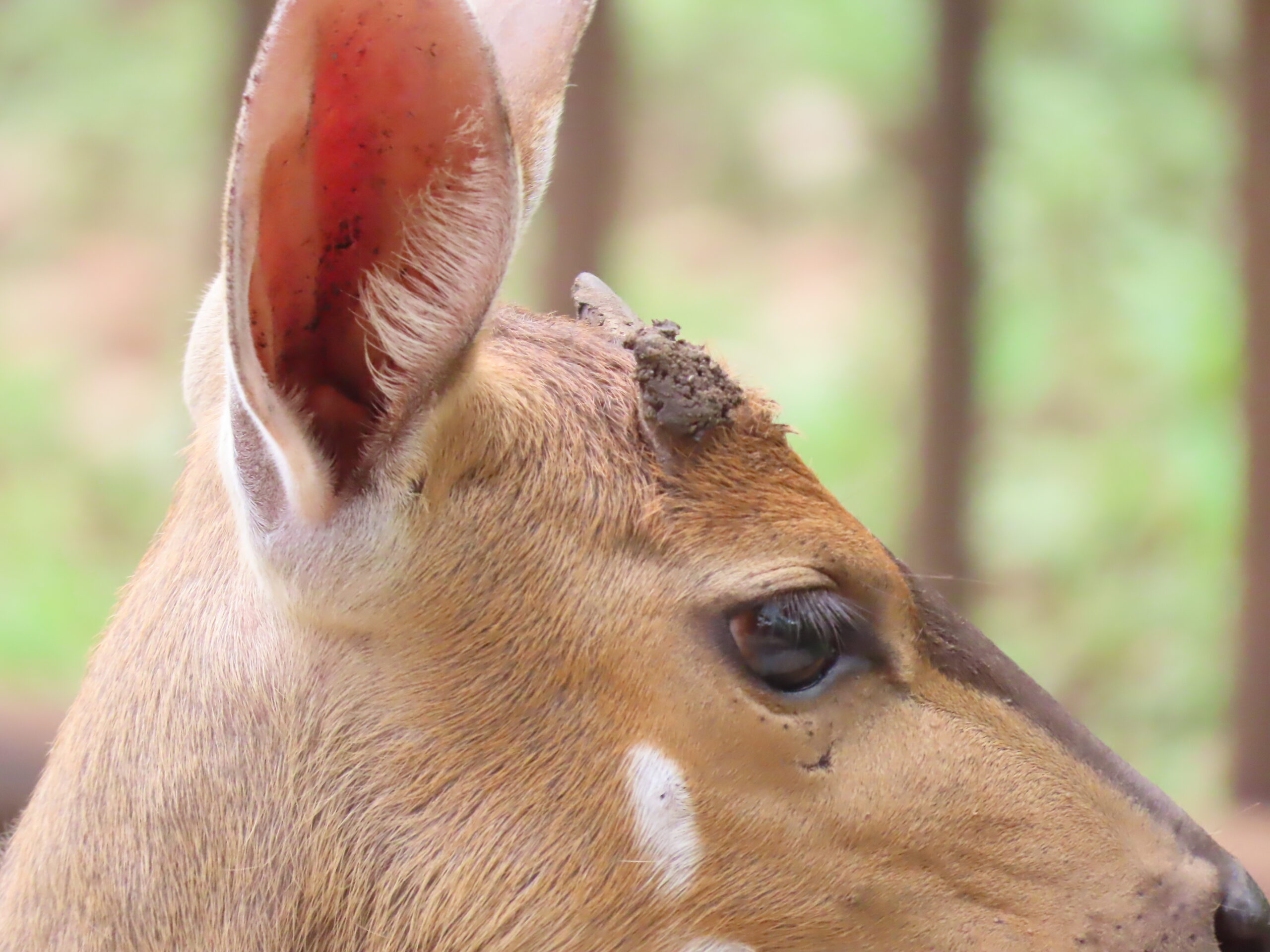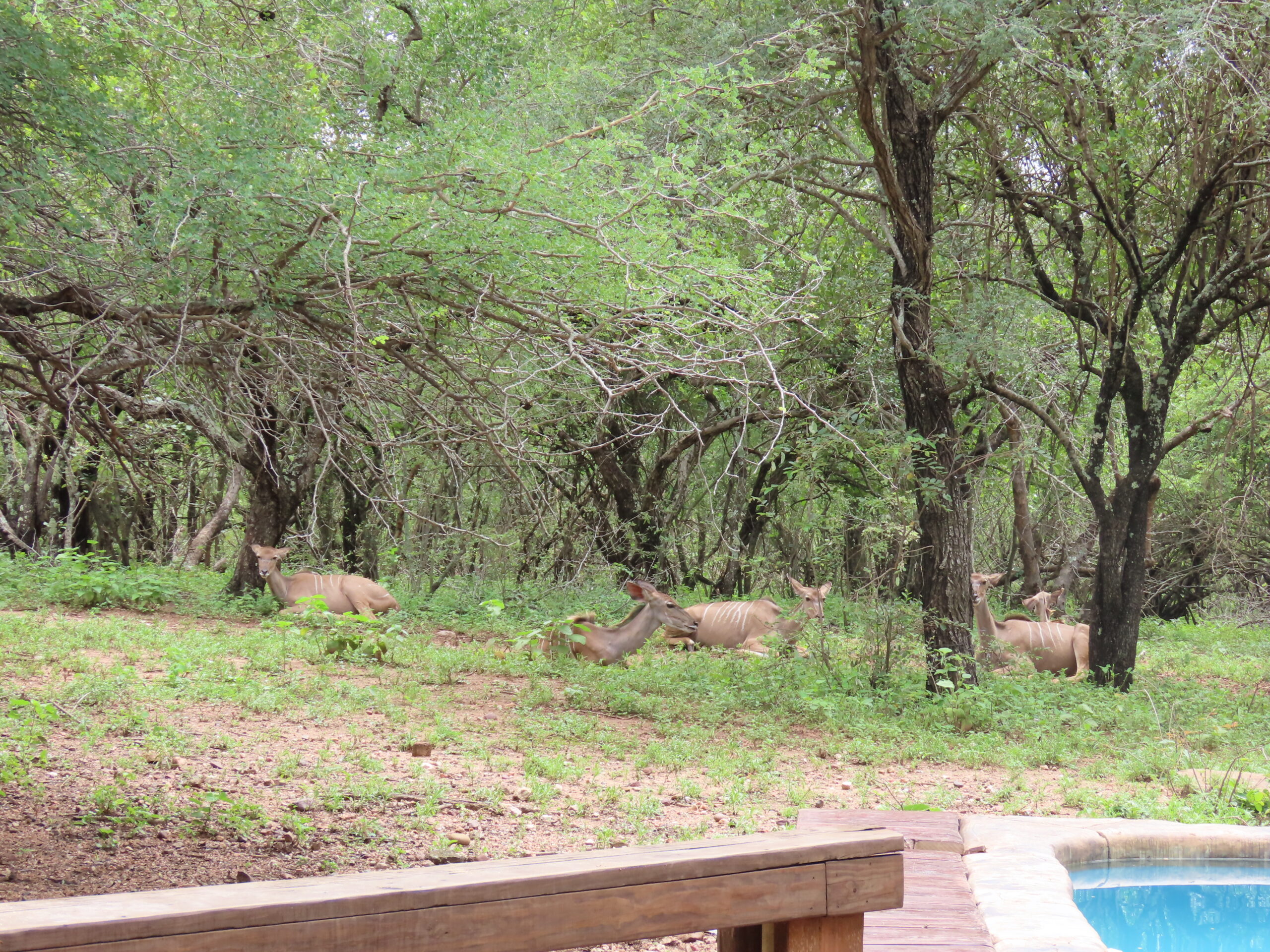Right now, at 11:00 am, the weather is as follows:
- Temperature: 77F, 25C,
- Humidity: 100%
- Dew Point: 78
Although the temperature is low, the humidity is unbearable. Wearing jeans and a long sleeve Bugs-Away shirt to keep from getting bites, I am drenched in sweat. It continues to rain a few times every 24 hours. I’d much rather have dry, hot days over this uncomfortable humid weather.

As shown in the above photo of Little Johnny, a young male bushbuck, many of the horned animals, even with tiny budding horns, are digging in the dirt to make themselves look bigger and more intimidating. Some animals dig in the ground with their tusks or horns, searching for edible roots.
With the dirt easily accessible after it’s been raining for weeks, we’ve seen many muddy horns. Even Norman stopped by a few evenings ago with his long horns covered in mud. Later we saw him digging in an anthill to add more dirt, the same anthill we’ve seen kudus, bushbucks, and warthogs attacking from time to time.
Animal behavior is quite interesting, and we look up information online about a particular animal’s behavior almost daily. Oddly, many wildlife species haven’t been studied extensively, and there may be little information about specific behaviors we observe while watching them day after day.

Many casual observers, such as us, speculate about animals’ behavior, but those observations may be incomplete and inaccurate. We often guess why a specific animal is acting a certain way, thus prompting us to conduct research. Of course, we’re always looking for information from reliable sources.
This morning, we watched a male kudu working very hard to take down a branch from a tree. We posted the above video about this behavior in 2018 and are excited to post it again today based on today’s topic. When looking online for “why do kudus knock down branches,” the answers are few and vague.
When we watch this behavior, we think it is for the kudu to eat the inaccessible leaves from higher up on the tree, as shown in our above video. But, often, as today, we watched a kudu pull down a large branch and never eat a single leaf once he’d knocked it down. Is there another reason he may have worked so hard to accomplish this feat?
There were other males and females nearby. Was he showing off his brute strength to intimidate the males and attract the females? It’s hard to find such information to substantiate this type of behavior.

When we’ve gone on a game drive with guides, their comments vary on animal behaviors. After watching wildlife daily for over three years, we keep our mouths shut about what we’ve observed when in a group. We’re no experts. Jane Goodall spent over 60 years studying and interacting with chimpanzees in the wild, yet she has said there is still much to learn.
As casual observers of animal behavior, our experience is uneducated, limited, and, at times, biased by our love and interest in certain animals. Not a day goes by that I’m not trying to discover the reason for the behaviors exhibited by nyala Norman. How did he and Nina kick Noah out of the family group to ensure he’d stop grazing with them and the new baby? We haven’t seen Noah since then. Others have reported they’ve seen him at least two kilometers from here. Will he ever return?
We’ll never know. Many observers claim to know and understand these various behaviors, but even with them, there is uncertainty. If only animals could talk and tell us the answers to these and other questions. But, like the mystery of life and the afterlife, we can only speculate. We, as humans, just aren’t meant to know some things.
We continue in our relentless pursuit of answers, which makes the search all the more fascinating. That uncertainty inspires us to be continually enthralled by wildlife and the world around us. From that source of motivation, we continue on in our world travels, hungry for more knowledge, connection, and fascination with Mother Nature’s bounty.
Be well.
Photo from one year ago today, February 17, 2022:

